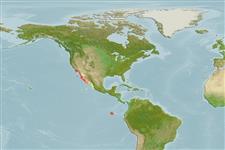>
Batrachoidiformes (Toadfishes) >
Batrachoididae (Toadfishes) > Porichthyinae
Etymology: Porichthys: Greek, poros = porous + Greek, ichthys = fish (Ref. 45335); myriaster: Porichthys pore fish, referring to the well-developed mucous system, myriaster numerous starss, for the abundant photophores (Ref. 4930).
More on authors: Hubbs & Schultz.
Environment: milieu / climate zone / depth range / distribution range
Écologie
marin démersal; profondeur 0 - 126 m (Ref. 9277). Subtropical; 35°N - 7°S, 123°W - 83°W
Eastern Pacific: Arguellow, California, USA to Almejas Bay, Baja California, Mexico. Also reported from northern Peru (Ref. 96339).
Taille / Poids / Âge
Maturity: Lm ? range ? - ? cm
Max length : 51.0 cm TL mâle / non sexé; (Ref. 2850)
Inhabits rocky areas and soft bottom, common in bays. Ranges from the intertidal zone to 126 m depth (Ref. 9277). Usually rests on or buries itself in bottom. Can create a humming or grunting sound. More active during night time.
Life cycle and mating behavior
Maturité | Reproduction | Frai | Œufs | Fécondité | Larves
Female attaches eggs to underside of rock. Male guards eggs and young.
Eschmeyer, W.N., E.S. Herald and H. Hammann, 1983. A field guide to Pacific coast fishes of North America. Boston (MA, USA): Houghton Mifflin Company. xii+336 p. (Ref. 2850)
Statut dans la liste rouge de l'IUCN (Ref. 130435: Version 2024-2)
Menace pour l'homme
Harmless
Utilisations par l'homme
Pêcheries: pêcheries vivrières
Outils
Articles particuliers
Télécharger en XML
Sources Internet
Estimates based on models
Preferred temperature (Ref.
123201): 15 - 22.9, mean 20.6 °C (based on 28 cells).
Phylogenetic diversity index (Ref.
82804): PD
50 = 0.5001 [Uniqueness, from 0.5 = low to 2.0 = high].
Bayesian length-weight: a=0.00537 (0.00305 - 0.00944), b=3.21 (3.05 - 3.37), in cm total length, based on LWR estimates for this species & Genus-body shape (Ref.
93245).
Niveau trophique (Ref.
69278): 4.3 ±0.57 se; based on food items.
Résilience (Ref.
120179): Faible, temps minimum de doublement de population : 4,5 à 14 années (Preliminary K or Fecundity.).
Fishing Vulnerability (Ref.
59153): Moderate vulnerability (40 of 100).
